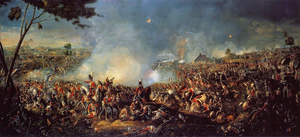Battle of Waterloo
| Battle of Waterloo | |||||||
|---|---|---|---|---|---|---|---|
| Part of the Waterloo Campaign | |||||||
 Battle of Waterloo by William Sadler |
|||||||
|
|||||||
| Belligerents | |||||||
|
|
Seventh Coalition: |
||||||
| Commanders and leaders | |||||||
|
|
|
||||||
| Strength | |||||||
|
Total: 73,000
|
Total: 118,000
|
||||||
| Casualties and losses | |||||||
|
Total: 41,000
|
Total: 24,000
Prussians: 7,000
|
||||||
|
Location within modern-day Belgium, then a part of the United Kingdom of the Netherlands
|
|||||||
Total: 73,000
Total: 118,000
Anglo-allies: 68,000
Total: 41,000
Total: 24,000
Anglo-allies: 17,000
Prussians: 7,000
The Battle of Waterloo was fought on Sunday, 18 June 1815, near Waterloo in present-day Belgium, then part of the United Kingdom of the Netherlands. A French army under the command of Napoleon Bonaparte was defeated by two of the armies of the Seventh Coalition: an Anglo-led Allied army under the command of the Duke of Wellington, and a Prussian army under the command of Gebhard Leberecht von Blücher, Prince of Wahlstatt.
Upon Napoleon's return to power in March 1815, many states that had opposed him formed the Seventh Coalition, and began to mobilize armies. Wellington and Blücher's armies were cantoned close to the north-eastern border of France. Napoleon chose to attack them in the hope of destroying them before they could join in a coordinated invasion of France with other members of the coalition. Napoleon successfully attacked the Prussians at the Battle of Ligny, while at the same time attacking the British at the Battle of Quatre Bras. Despite holding his ground at Quatre Bras, the defeat of the Prussians forced Wellington to withdraw to Waterloo. Napoleon sent a third of his forces to pursue the Prussians, who had withdrawn parallel to Wellington. This resulted in the separate and simultaneous Battle of Wavre with the Prussian rear-guard.
...
Wikipedia

